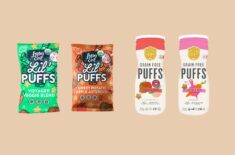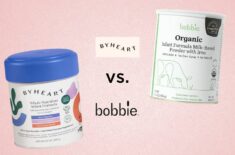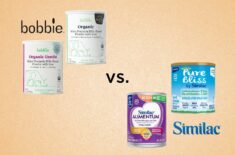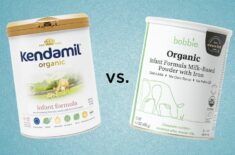Overview
If your little one is ready to eat solid foods, can you still trust commercial baby food purees when recent baby food safety reports showed that they may contain high levels of toxic elements? (1)(2)(3)
That’s why some parents choose to create homemade purees to give their babies first foods with veggies and fruits prepared from fresh ingredients.
You can find some homemade baby food recipes below, plus a list of the kitchen appliances and ingredients you’ll need to prepare. You can also find tips on how you can introduce your baby to table food once they’re ready.
Make sure to consult with your pediatrician about the best and safe foods to give your baby, especially if they have allergies, sensitivities, or certain dietary restrictions.
Tips For Making Your Own Baby Food
Choosing the Right Foods
According to the AAP (American Academy of Pediatrics), you don’t have to give kids food in a certain order. They can begin eating solid foods at six months of age. (4)(5)
By the time they’re around seven or eight months old, they can eat different foods from a variety of food groups. (4)(5)
But as much as 95% of commercial baby foods may contain high levels of heavy metals. So, the AAP recommends that parents give their children a wide variety of foods to help reduce the concentration of these toxic elements in their young bodies. (6)(7)
One thing you can do is prepare your own baby food at home.
Is It Cheaper To Make Your Own Baby Food?
Making baby food can be a cheaper, healthier option to commercial baby foods. You can have control over which ingredients to use and what your baby’s first foods will be.
There are many ways to make your own baby food. You can even experiment with how much water and which ingredients to use to find the right consistency.
Textures for your baby to try: (4)
- Smooth (pureed or strained)
- Lumpy or mashed
- Ground or finely chopped
How Do You Make Pureed Baby Food?
Steaming or boiling can be a good way of making your baby’s first foods softer and easier to digest. It would be especially helpful for harder fruits and vegetables, including apples.
Afterward, you can make pureed food using a blender or food processor. You can also opt to use a baby food maker, some of which are designed for use with reusable food pouches.
In making puree, check if the fruit or vegetable has rich water content. For example, pears have a lot of natural juices, so you may not need to add any water if you’re using them.
If you want more texture, you can opt to mash the cooked food.
Ingredients To Try
These are some of the ingredients you can use for preparing homemade baby food: (6)
- Quality meats, poultry, or fish
- Healthy fats (coconut oil, olive oil, or ghee)
- Whole or puree vegetables
- Fresh fruits (avocados, apples, bananas, peaches, grapes, and strawberries)
- Applesauce (unsweetened)
- Organic eggs
- Bone broth
- Raw yogurt
- Coconut yogurt
- Quinoa
- Oats
Foods, Drinks, And Ingredients To Avoid
In making baby food at home, keep these in mind: (6)(8)
- Avoid brown rice. It can have a higher arsenic content than white rice.
- Possible healthier alternatives to brown rice are sushi rice from the US and white basmati rice from California, Pakistan, and India.
- Limit intake of infant rice cereal.
- You may also reduce arsenic levels by cooking rice with much larger portions of water (6 to 10 parts for every 1 part rice). Make sure to drain the water afterward.
- You should feed your child carrots and sweet potatoes in moderation because these can have higher levels of lead or cadmium. Yet you can’t completely take them out of your child’s diet because they are essential sources of vitamin A and other nutrients.
- Avoid high-mercury fish: orange roughy, bigeye tuna, king mackerel, shark, and swordfish.
- Don’t use sugar-sweetened drinks, including flavored milk or flavored water.
- Avoid chocolates.
- Avoid adding processed or refined sugars.
- Don’t give honey or foods with honey to children below 12 months old.
- Don’t give your child unpasteurized foods or drinks (sometimes marketed as “raw milk”)
- Avoid using processed fruit juices.
- Avoid adding processed foods such as canned meats, hot dogs, sausages, and ham.
- Never give coffee or other caffeinated beverages (soft drinks or soda, sports drinks, hot or cold tea, or milk tea) to a child less than 12 months old.
Choking Hazards In Homemade Foods
When it’s time to introduce your little one to harder solids, always make sure to check for possible choking hazards. (9)(10)
Keep the pieces small enough for your baby to swallow even without chewing.
Always check for these potential choking hazards: (10)
- Thick, sticky foods
- Uncut or whole blueberries, cherries, or grapes
- Cooked or raw whole corn kernels
- Whole pieces of canned fruit
- Uncooked or dried vegetables and fruits, such as raisins
- Whole or chopped nuts
- Whole or chopped seeds
- Large or tough chunks of meat
- Large chunks of cheese, especially mozzarella or string cheese
- Bones in fish or meat
- Whole beans (kidney beans, green beans, etc.)
- Chewy or gummy fruit snacks
- Plain wheat germ
- Whole grain kernels of cooked barley, wheat, and other grains
- Potato or corn chips, popcorn, pretzels, hard baby cereal, or similar snack foods
- Hard baby cereals
- Marshmallows
- Cookies, teething biscuits, or granola bars
Baby Food Safety During Preparation & Storage
Children five years old and below are more susceptible to foodborne illness. They can develop health complications due to their still-developing immune systems. Also, kids this age aren’t old enough to produce enough stomach acids to kill harmful bacteria. (11)
So, food safety should always be your top priority in preparing homemade baby food, especially if you’ll store this in the fridge. You can follow these guidelines: (11)
- In making baby food, always make sure that everything is clean: your hands, the kitchen table, all kitchen appliances, all ingredients, and every food container you’ll use.
- Keep your baby’s ready-to-eat food away from raw meat, seafood, poultry, and eggs because these can spread illness-causing bacteria.
- Food poisoning bacteria multiply the quickest between 40°F and 140°F. So, refrigerate your freshly prepared baby food promptly.
Make sure to label the jars with the date you made them and the estimated expiry date based on these ideal storage limits for homemade baby food: (11)
Fruits and vegetables
- Fridge: 2 to 3 days
- Freezer: 6 to 8 months
Meats and eggs
- Fridge: 1 day
- Freezer: 1 to 2 months
Meat/vegetable combinations
- Fridge: 1 to 2 days
- Freezer: 1 to 2 months
Other homemade baby foods
- Fridge: 1 to 2 days
- Freezer:1 to 2 months
What Do You Need To Make Your Own Baby Food?
These are some of the kitchen appliances that you might need in preparing your baby’s food:
- Baby food maker
- Baby food grinder
- Food processor
- Blender
- Grinder
- Steamer
- Strainer
- Cutting boards
- Storage containers
- Freezer bags
- Ice cube trays
- Airtight container
- Food mill
- Steamer basket
- Immersion blender
- Potato masher
Recipes To Try: How Do I Make Baby Food For The First Time?
Single-Ingredient (Stage 1) Baby Food Recipe
For your baby’s first solid foods, single-ingredient purees are the ideal choice. You may introduce these foods to babies six months old and above.
If you’re planning on giving solids to infants less than six months old, make sure to consult your pediatrician. Always keep the meal a single-ingredient, gluten-free, and allergy-free puree.
Avocado Puree
Avocados are a rich source of omega-3 fatty acids, which are great for your baby’s brain development. So, avocado puree can be a good choice for your baby’s first food.
Here’s how to make some:
Ingredients:
- One ripe avocado
- Liquids (breast milk, formula, bone broth, or water), the amount depends on your desired consistency
Procedure:
- Cut a ripe avocado in half. Make sure to remove the pit before scooping up the flesh.
- Put it inside a food processor or blender.
- If it’s too thick, gradually add the liquid until you achieve the desired consistency.
- Divide into baby-meal-sized portions and store in small containers.
- You can also serve it fresh.
Multi-Ingredient (Stage 2) Baby Food Recipe
As your child grows accustomed to single-ingredient purees, you can begin adding multi-ingredient purees or mashed baby foods. It can start anywhere from six months to around 10 months old.
You still have to make sure that your baby is not allergic to any of the ingredients. So, choose only the ones that you’ve already tested with the single-ingredient foods.
To encourage your baby’s palate for a wide range of foods, introduce a variety of vegetables, fruits, grains, and meats.
Beets, Avocado, and Butternut Squash
Beets are rich sources of vitamin C. They’ll make a great addition to avocados.
Here’s a simple multi-ingredient recipe to follow:
Ingredients:
- One ripe avocado
- 1 cup beets, peeled and cubed
- 1 cup butternut squash, peeled and cubed
Procedure:
- Cut the avocado (make sure it’s ripe) in half. Remove the pit, then scrape it into a container.
- Peel the beets and chop them into small cubes.
- Peel and cut the butternut squash into small cubes, the same size as the beets.
- Place the beets and butternut squash in a cooking container and bake (350 F) or steam them until soft. It might take around 30 minutes.
- Once these vegetables are soft, you can prepare the baby food that your child prefers. For example, you can blend this if your child likes puree or simply put them together in a bowl for your child to pick if you’re trying out baby-led weaning.
Meat & Vegetable Recipe
You can also try to add some meat to your child’s diet. Grass-fed beef and chicken sourced from organic farms can be a great choice.
Ingredients:
- 1 lb organic chicken or meat
- Bone broth
- 1 cup spinach
- 1 cup broccoli
- 1 cup sweet potatoes
- 1 tsp salt (but you may add more to taste)
- 2 tbsp organic, cultured grass-fed ghee or 1 tbsp extra virgin olive oil (not cooked)
Procedure:
- Cook the meat by baking at 350 F or steaming until it is thoroughly cooked.
- Steam the vegetables until well cooked.
- Add the broth.
- Add salt to taste.
- Allow your cooked meat and vegetables to cool down. Mix and puree all the ingredients in a food processor or blender.
- Once all the food items have been blended well, you can opt to drizzle a little virgin olive oil. Then, blend for 30 seconds more.
Finger Food (Stage 3) Recipe
By the time your baby is at least 10 months old, you may begin to introduce finger foods or other items with bits and pieces of fruits, meats, or vegetables.
Pea Fritters
Ideal for toddlers and big kids, pea fritters are finger foods that you can prepare with other vegetables, feta cheese, and light seasoning.
Ingredients:
- 1 to 1 ¼ cup frozen green peas
- Two organic eggs, lightly beaten
- 4.4 oz feta cheese (or for a dairy-free alternative almond ricotta)
- ½ cup gluten-free flour (almond flour or oat flour)
- A handful of spinach leaves
- A handful of mint leaves
- A handful of cilantro (aka coriander) leaves
- 1 tbsp lemon juice
- Coconut or avocado oil for frying
Procedure:
- Boil the green peas until tender.
- While waiting, prepare the other ingredients: mince the mint, coriander, and spinach leaves, and cube the feta cheese.
- Once the green peas are ready, allow them to cool before mixing with the gluten-free flour, mint, coriander, spinach leaves, and cheese.
- Blend well until you get a crumbly consistency.
- Add the eggs and lemon juice. Mix again.
- Make small balls, just about the size of a spoon.
- Heat your oil in a pan on medium heat.
- Scoop the balls into the pan and lightly press using two spoons to create small patties.
- Then, fry for a few minutes or until golden brown. Drain on paper towels or pat down to remove excess oil.
You can serve these finger foods with a healthy dip, such as yogurt.
To store for future use, put them in containers and immediately freeze.
Baby Feeding Safety
Whether you choose to make homemade baby food or feed your baby with commercial ones, you should always follow these baby feeding safety guidelines: (11)(12)
- Always wash your hands before (and after) preparing your baby’s food.
- Always wash your child’s hands before mealtimes.
- Always check the baby utensils for cracks and potential health or safety hazards before using them.
- Always check any food you give to your baby if it’s at the right temperature (lukewarm or room temperature).
- Always check for any potential choking hazards.
- Avoid hard or sticky foods.
- Don’t let your child recline or lie down while eating; discourage them from crawling, walking, or running around.
- Strap your child in a high chair or put them safely on a sturdy seat
- Always keep mealtimes calm; avoid disruptions, and don’t rush your little one into finishing their food
- Always focus on your child while they’re eating, especially children below two years old
- Limit distractions such as watching TV or using cell phones while feeding
- Always make sure your child is only putting small amounts of food in their mouths
If possible, learn ahead of time what you should do if your child chokes on their food from your pediatrician or any doctor.
One last tip: be patient.
Baby feeding time can be messy, especially during the first few months. At this time, your baby is still learning how to use feeding utensils or might be more interested in playing with their food.
Let your child use their fingers to pick up food because this can help them develop their fine motor skills and interest in food.
Introducing New Foods
In introducing new food to your baby, you can follow these tips: (4)(6)
- Consult your pediatrician for foods that are safe for your baby to eat. Note that some babies might have some allergies or conditions that cause sensitivity to certain foods.
- If you’re unsure, you may start with gluten-free, allergen-free options.
- It might also be helpful to seek help from a dietitian to provide your baby with nutritious, healthy foods that are age-appropriate.
- Introduce new food slowly. Let your baby try a single-ingredient food at a time. Try to wait for around three to five days before introducing another ingredient. It can help you rule out food allergies, if any.
- Make sure that you are feeding baby food at room temperature. Foods that are too hot or too cold can harm your baby’s mouth.
- You can introduce your baby’s taste buds to a variety of flavors and textures. It can help your child learn to accept different tastes and avoid becoming a picky eater.
- You can try giving peanut butter to your baby, but make sure your child’s not allergic to peanuts, and the concentration isn’t too sticky.
Introducing Your Baby To Table Food
Babies might have a different feeding schedule than other children because they eat more often but in smaller quantities.
But you can also let some of these schedules coincide with mealtime hours of the rest of the family. It can help the younger children bond with other family members and transition to eating table food.
How Much Food To Give Your Child
There’s no specific amount or food weight to follow, but remember that their bellies are small and can easily become full.
You can follow these tips: (9)
- Start small with just one or two tablespoons of food for younger babies, especially if it’s their first time to eat.
- Check for signs that your child is already full: closes their mouth and refuses to take another bite, turns their head away from food, relaxes their hands, or uses sounds and hand motions to refuse more food. But these can also be signs that they don’t like the taste of the food. You can learn the difference by observing your child during mealtime.
- Don’t make food a reward or punishment.
- Let your child have their fill of the food and decide how much they want. Don’t force them to finish a bottle or the food on their plate.
- Talk to your child’s pediatrician for any food-related concerns, especially if you think your baby is eating too much or too little.
Baby Feeding Essentials
These are some of the items or products you may need for feeding your baby:
- High chair
- Small spoon
- Clean bib
- Sippy cup or small, unbreakable drinking cup
- Unbreakable, baby-safe bowl or plate
Safety Guidelines in Reheating Baby Foods
Make sure to follow these safety guidelines in reheating your baby’s foods: (11)(12)
- Just like breast milk or formula, you should completely defrost any frozen baby food before giving it to your child, but any leftover food should be discarded.
- Don’t be tempted to put it back in the fridge or freezer even if there’s still a lot left inside the container. Harmful bacteria can easily grow in leftover food and cause food poisoning or other health concerns.
- Don’t microwave baby foods that contain meat, eggs, or meat sticks. Heat them in a pan on a stove instead. The high fat content of these foods could make these portions heat up faster, leading to overheating or splattering.
- Don’t microwave baby food in jars. Transfer to a dish so you can stir the food and check the temperature. It should be lukewarm.
- Microwave around 4 oz of baby food per meal using high power for 15 seconds. Stir and let stand for at least 30 seconds. Taste-test to make sure it’s not too hot before giving it to your baby.
Is Jarred Baby Food Really That Bad?
Congressional Reports in February and September 2021 revealed that several popular baby food brands contain alarmingly high levels of arsenic, mercury, lead, and cadmium. (1)
Heavy metals which can cause IQ decline and behavioral problems in children. (2)(3)
These brands were called out for their toxic metal contents but none issued any food safety warning or recall concerning the Congressional reports: (1)(13)
- Nurture, Inc. (Baby Food Recall and HappyTOT)
- Beech-Nut Nutrition Company (Beech-Nut)
- Hain Celestial Group, Inc. (Earth’s Best Organic)
- Gerber
- Campbell’s Plum Organics
- Walmart Inc. (Parent’s Choice)
- Sprout Foods, Inc. (Sprout Organic Foods)
Healthier Commercial Baby Food Products
These are some baby food products that may be healthier options for your baby:
- Little Spoon (subscription-based organic baby food)
- Yumi (subscription-based organic baby food)
- Serenity Kids
- Little Journey Organics
- Once Upon A Farm
REFERENCES
(1) http://www.healthybabyfood.org/sites/healthybabyfoods.org/files/2019-10/BabyFoodReport_FULLREPORT_ENGLISH_R5b.pdf
(2) https://pubmed.ncbi.nlm.nih.gov/23570911/
(3) https://www.ncbi.nlm.nih.gov/pmc/articles/PMC4418502/
(4) https://www.cdc.gov/nutrition/infantandtoddlernutrition/foods-and-drinks/when-to-introduce-solid-foods.html
(5) https://www.cdc.gov/nutrition/infantandtoddlernutrition/foods-and-drinks/when-to-introduce-solid-foods.html
(6) http://www.healthybabyfood.org/sites/healthybabyfoods.org/files/2019-10/BabyFoodReport_FULLREPORT_ENGLISH_R5b.pdf
(7) https://www.aappublications.org/news/2021/05/01/parentplus-babyfoodmetal050121
(8) https://www.cdc.gov/nutrition/InfantandToddlerNutrition/foods-and-drinks/foods-and-drinks-to-limit.html
(9) https://www.cdc.gov/nutrition/infantandtoddlernutrition/mealtime/signs-your-child-is-hungry-or-full.html
(10) https://www.cdc.gov/nutrition/InfantandToddlerNutrition/foods-and-drinks/choking-hazards.html
(11) https://www.foodsafety.gov/people-at-risk/children-under-five
(12) https://www.cdc.gov/nutrition/InfantandToddlerNutrition/mealtime/mealtime-routines-and-tips.html
(13) https://oversight.house.gov/sites/democrats.oversight.house.gov/files/ECP%20Second%20Baby%20Food%20Report%209.29.21%20FINAL.pdf












